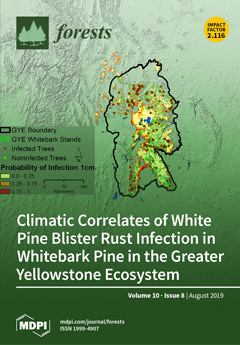Both leaf area (
LA) and leaf angle distribution are the most important eco-physiological measures of tree crowns. However, there are limited published investigations on the two parameters of Moso bamboo (
Phyllostachys edulis (Carrière) J. Houz., abbreviated as MB). The aim
[...] Read more.
Both leaf area (
LA) and leaf angle distribution are the most important eco-physiological measures of tree crowns. However, there are limited published investigations on the two parameters of Moso bamboo (
Phyllostachys edulis (Carrière) J. Houz., abbreviated as MB). The aim of this study was to develop allometric equations for predicting crown
LA of MB by taking the diameter at breast height (
DBH) and tree height (
H) as predictors and to investigate the leaf angle distribution of a MB crown based on direct leaf angle measurements. Data were destructively sampled from 29 MB crowns including
DBH,
H, biomass and the area of sampled leaves, biomass of total crown leaves, and leaf angles. The results indicate that (1) the specific leaf area (
SLA) of a MB crown decreases from the bottom to the top; (2) the vertical
LA distribution of MB crowns follow a “Muffin top” shape; (3) the
LA of MB crowns show large variations, from 7.42 to 74.38 m
2; (4) both
DBH and
H are good predictors in allometry-based
LA estimations for a MB crown; (5) linear, exponential, and logarithmic regressions show similar capabilities for the
LA estimations; (6) leaf angle distributions from the top to the bottom of a MB crown can be considered as invariant; and (7) the leaf angle distribution of a MB crown is close to the planophile case. The results provide an important tool to estimate the
LA of MB on the standing scale based on
DBH or
H measurements, provide useful prior knowledge for extracting leaf area indexes of MB canopies from remote sensing-based observations, and, therefore, will potentially serve as a crucial reference for calculating carbon balances and other ecological studies of MB forests.
Full article





